Understanding Child and Young People Development in Residential Care
VerifiedAdded on 2023/01/13
|23
|8199
|57
Homework Assignment
AI Summary
This assignment, designed for a Level 4 Higher Apprenticeship in Residential Childcare, explores the multifaceted aspects of child and young people's development within residential care settings. It delves into the influences of both personal factors, such as health, disabilities, and learning difficulties, and external factors, including poverty, family environment, neglect, trauma, and personal choices. The assignment further examines how theories of development, like Piaget's cognitive theory, inform and shape current practices in residential childcare, providing examples of their application. The student demonstrates an understanding of the complex interplay of these factors and their impact on the well-being and development of children and young people in care, emphasizing the importance of tailored support and intervention strategies.
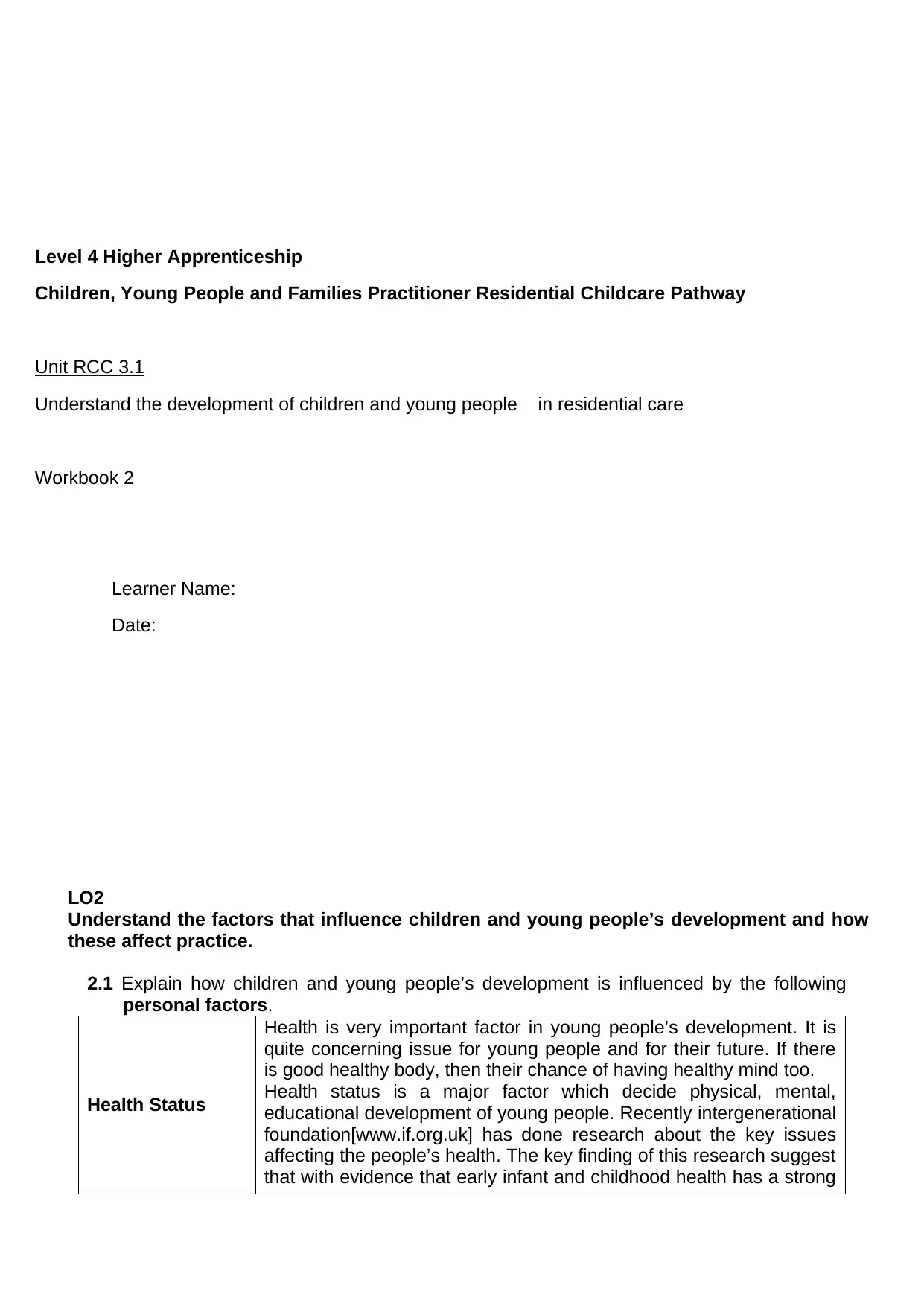
Level 4 Higher Apprenticeship
Children, Young People and Families Practitioner Residential Childcare Pathway
Unit RCC 3.1
Understand the development of children and young people in residential care
Workbook 2
Learner Name:
Date:
LO2
Understand the factors that influence children and young people’s development and how
these affect practice.
2.1 Explain how children and young people’s development is influenced by the following
personal factors.
Health Status
Health is very important factor in young people’s development. It is
quite concerning issue for young people and for their future. If there
is good healthy body, then their chance of having healthy mind too.
Health status is a major factor which decide physical, mental,
educational development of young people. Recently intergenerational
foundation[www.if.org.uk] has done research about the key issues
affecting the people’s health. The key finding of this research suggest
that with evidence that early infant and childhood health has a strong
Children, Young People and Families Practitioner Residential Childcare Pathway
Unit RCC 3.1
Understand the development of children and young people in residential care
Workbook 2
Learner Name:
Date:
LO2
Understand the factors that influence children and young people’s development and how
these affect practice.
2.1 Explain how children and young people’s development is influenced by the following
personal factors.
Health Status
Health is very important factor in young people’s development. It is
quite concerning issue for young people and for their future. If there
is good healthy body, then their chance of having healthy mind too.
Health status is a major factor which decide physical, mental,
educational development of young people. Recently intergenerational
foundation[www.if.org.uk] has done research about the key issues
affecting the people’s health. The key finding of this research suggest
that with evidence that early infant and childhood health has a strong
Paraphrase This Document
Need a fresh take? Get an instant paraphrase of this document with our AI Paraphraser
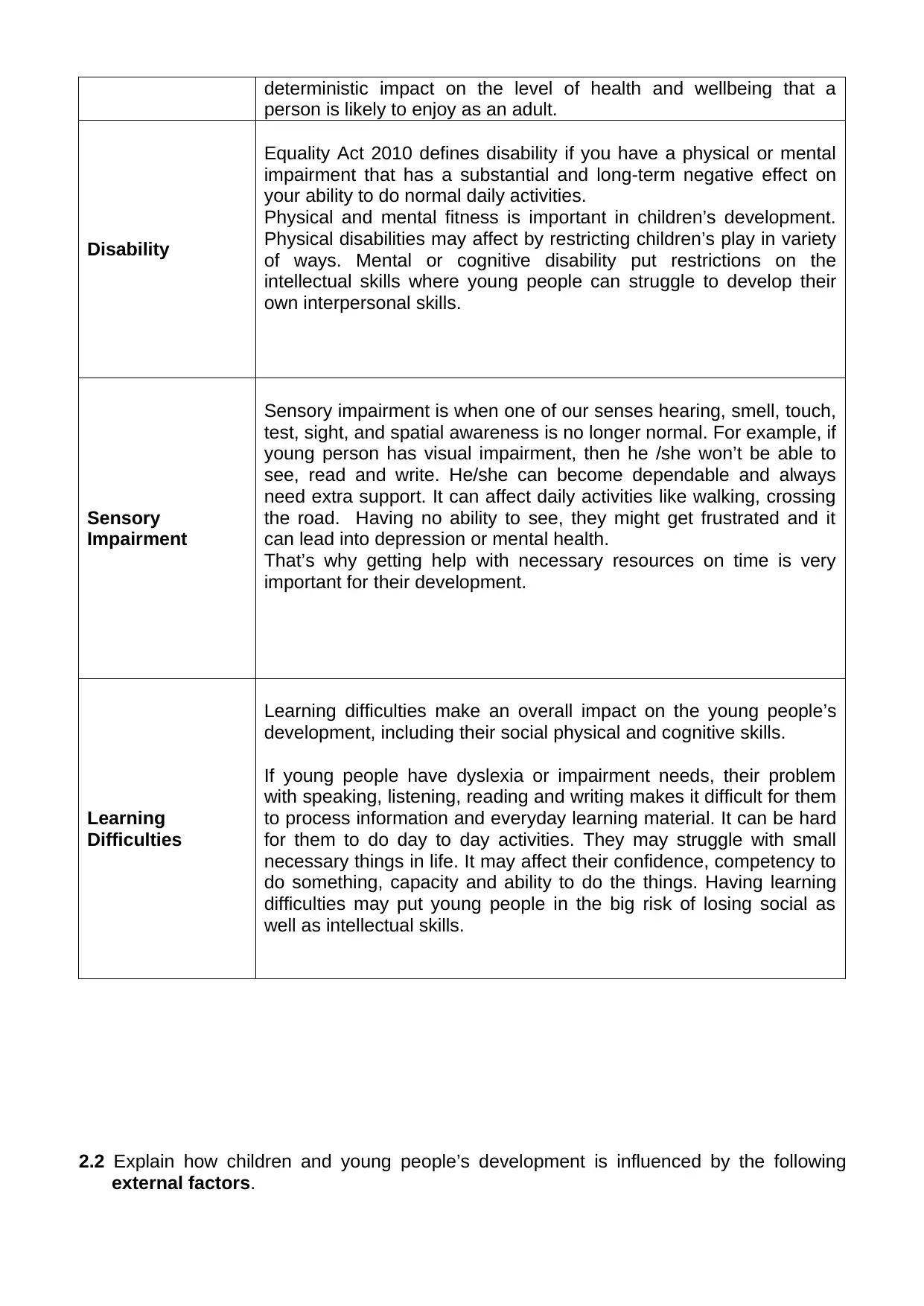
deterministic impact on the level of health and wellbeing that a
person is likely to enjoy as an adult.
Disability
Equality Act 2010 defines disability if you have a physical or mental
impairment that has a substantial and long-term negative effect on
your ability to do normal daily activities.
Physical and mental fitness is important in children’s development.
Physical disabilities may affect by restricting children’s play in variety
of ways. Mental or cognitive disability put restrictions on the
intellectual skills where young people can struggle to develop their
own interpersonal skills.
Sensory
Impairment
Sensory impairment is when one of our senses hearing, smell, touch,
test, sight, and spatial awareness is no longer normal. For example, if
young person has visual impairment, then he /she won’t be able to
see, read and write. He/she can become dependable and always
need extra support. It can affect daily activities like walking, crossing
the road. Having no ability to see, they might get frustrated and it
can lead into depression or mental health.
That’s why getting help with necessary resources on time is very
important for their development.
Learning
Difficulties
Learning difficulties make an overall impact on the young people’s
development, including their social physical and cognitive skills.
If young people have dyslexia or impairment needs, their problem
with speaking, listening, reading and writing makes it difficult for them
to process information and everyday learning material. It can be hard
for them to do day to day activities. They may struggle with small
necessary things in life. It may affect their confidence, competency to
do something, capacity and ability to do the things. Having learning
difficulties may put young people in the big risk of losing social as
well as intellectual skills.
2.2 Explain how children and young people’s development is influenced by the following
external factors.
person is likely to enjoy as an adult.
Disability
Equality Act 2010 defines disability if you have a physical or mental
impairment that has a substantial and long-term negative effect on
your ability to do normal daily activities.
Physical and mental fitness is important in children’s development.
Physical disabilities may affect by restricting children’s play in variety
of ways. Mental or cognitive disability put restrictions on the
intellectual skills where young people can struggle to develop their
own interpersonal skills.
Sensory
Impairment
Sensory impairment is when one of our senses hearing, smell, touch,
test, sight, and spatial awareness is no longer normal. For example, if
young person has visual impairment, then he /she won’t be able to
see, read and write. He/she can become dependable and always
need extra support. It can affect daily activities like walking, crossing
the road. Having no ability to see, they might get frustrated and it
can lead into depression or mental health.
That’s why getting help with necessary resources on time is very
important for their development.
Learning
Difficulties
Learning difficulties make an overall impact on the young people’s
development, including their social physical and cognitive skills.
If young people have dyslexia or impairment needs, their problem
with speaking, listening, reading and writing makes it difficult for them
to process information and everyday learning material. It can be hard
for them to do day to day activities. They may struggle with small
necessary things in life. It may affect their confidence, competency to
do something, capacity and ability to do the things. Having learning
difficulties may put young people in the big risk of losing social as
well as intellectual skills.
2.2 Explain how children and young people’s development is influenced by the following
external factors.
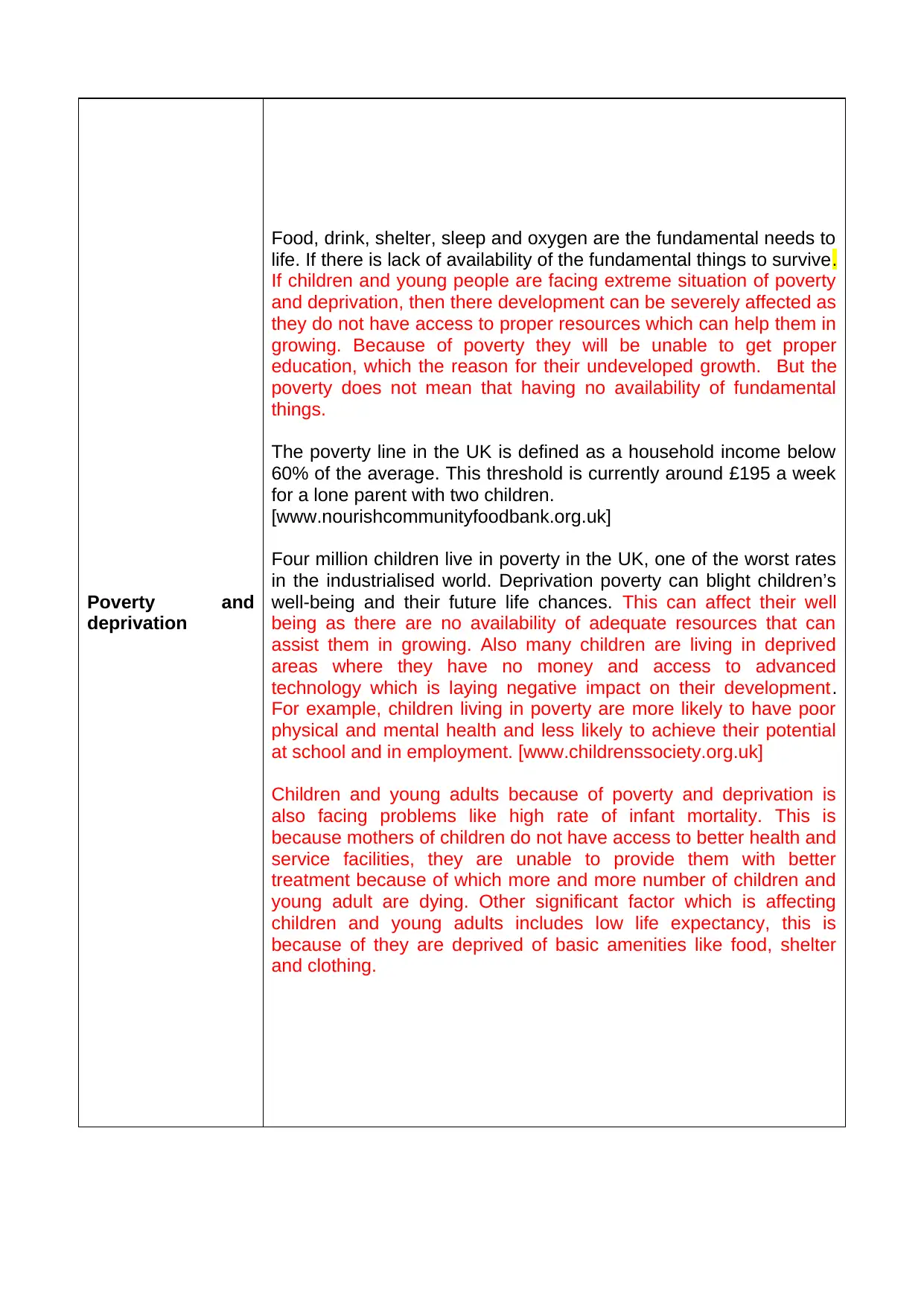
Poverty and
deprivation
Food, drink, shelter, sleep and oxygen are the fundamental needs to
life. If there is lack of availability of the fundamental things to survive.
If children and young people are facing extreme situation of poverty
and deprivation, then there development can be severely affected as
they do not have access to proper resources which can help them in
growing. Because of poverty they will be unable to get proper
education, which the reason for their undeveloped growth. But the
poverty does not mean that having no availability of fundamental
things.
The poverty line in the UK is defined as a household income below
60% of the average. This threshold is currently around £195 a week
for a lone parent with two children.
[www.nourishcommunityfoodbank.org.uk]
Four million children live in poverty in the UK, one of the worst rates
in the industrialised world. Deprivation poverty can blight children’s
well-being and their future life chances. This can affect their well
being as there are no availability of adequate resources that can
assist them in growing. Also many children are living in deprived
areas where they have no money and access to advanced
technology which is laying negative impact on their development.
For example, children living in poverty are more likely to have poor
physical and mental health and less likely to achieve their potential
at school and in employment. [www.childrenssociety.org.uk]
Children and young adults because of poverty and deprivation is
also facing problems like high rate of infant mortality. This is
because mothers of children do not have access to better health and
service facilities, they are unable to provide them with better
treatment because of which more and more number of children and
young adult are dying. Other significant factor which is affecting
children and young adults includes low life expectancy, this is
because of they are deprived of basic amenities like food, shelter
and clothing.
deprivation
Food, drink, shelter, sleep and oxygen are the fundamental needs to
life. If there is lack of availability of the fundamental things to survive.
If children and young people are facing extreme situation of poverty
and deprivation, then there development can be severely affected as
they do not have access to proper resources which can help them in
growing. Because of poverty they will be unable to get proper
education, which the reason for their undeveloped growth. But the
poverty does not mean that having no availability of fundamental
things.
The poverty line in the UK is defined as a household income below
60% of the average. This threshold is currently around £195 a week
for a lone parent with two children.
[www.nourishcommunityfoodbank.org.uk]
Four million children live in poverty in the UK, one of the worst rates
in the industrialised world. Deprivation poverty can blight children’s
well-being and their future life chances. This can affect their well
being as there are no availability of adequate resources that can
assist them in growing. Also many children are living in deprived
areas where they have no money and access to advanced
technology which is laying negative impact on their development.
For example, children living in poverty are more likely to have poor
physical and mental health and less likely to achieve their potential
at school and in employment. [www.childrenssociety.org.uk]
Children and young adults because of poverty and deprivation is
also facing problems like high rate of infant mortality. This is
because mothers of children do not have access to better health and
service facilities, they are unable to provide them with better
treatment because of which more and more number of children and
young adult are dying. Other significant factor which is affecting
children and young adults includes low life expectancy, this is
because of they are deprived of basic amenities like food, shelter
and clothing.
⊘ This is a preview!⊘
Do you want full access?
Subscribe today to unlock all pages.

Trusted by 1+ million students worldwide
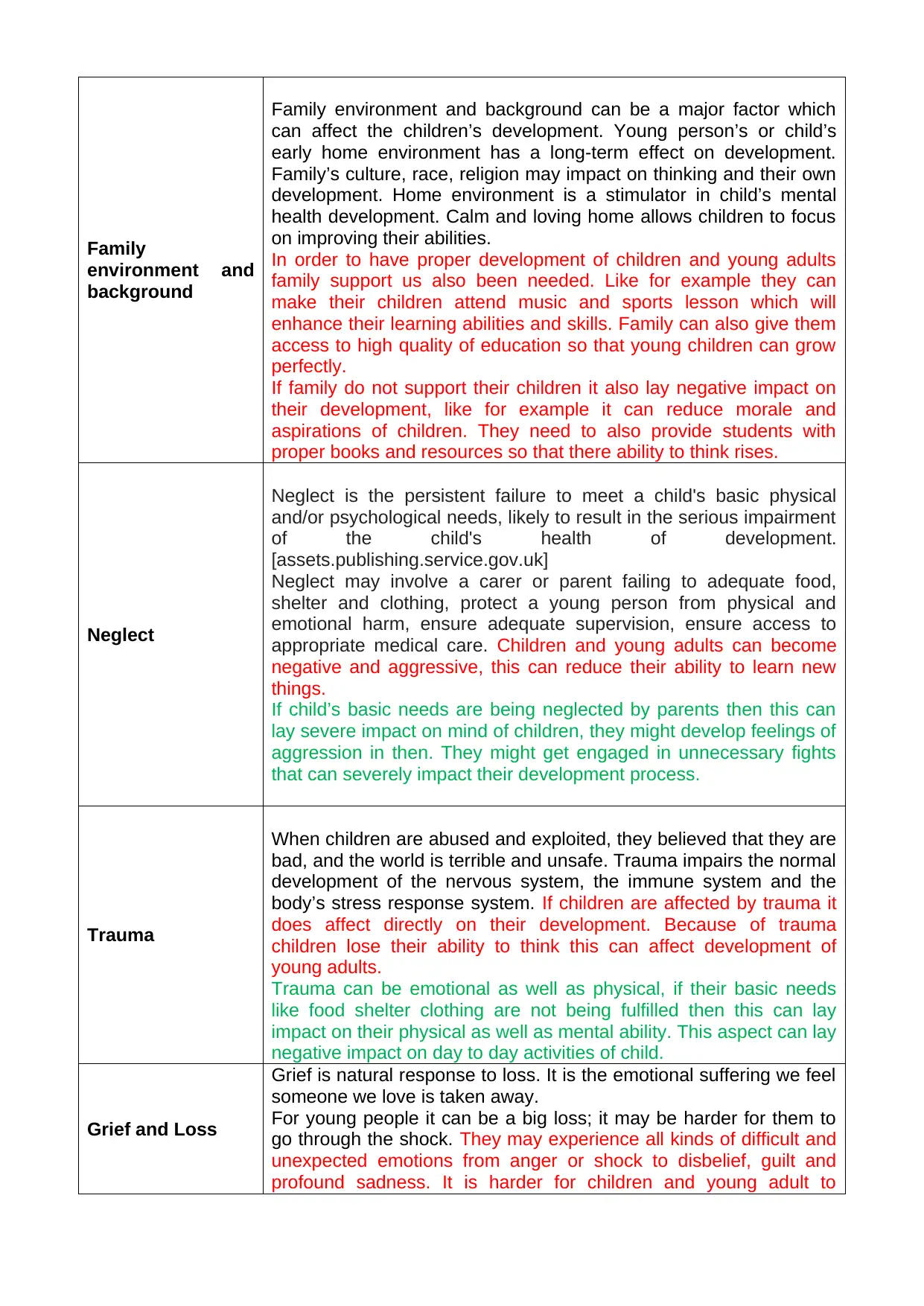
Family
environment and
background
Family environment and background can be a major factor which
can affect the children’s development. Young person’s or child’s
early home environment has a long-term effect on development.
Family’s culture, race, religion may impact on thinking and their own
development. Home environment is a stimulator in child’s mental
health development. Calm and loving home allows children to focus
on improving their abilities.
In order to have proper development of children and young adults
family support us also been needed. Like for example they can
make their children attend music and sports lesson which will
enhance their learning abilities and skills. Family can also give them
access to high quality of education so that young children can grow
perfectly.
If family do not support their children it also lay negative impact on
their development, like for example it can reduce morale and
aspirations of children. They need to also provide students with
proper books and resources so that there ability to think rises.
Neglect
Neglect is the persistent failure to meet a child's basic physical
and/or psychological needs, likely to result in the serious impairment
of the child's health of development.
[assets.publishing.service.gov.uk]
Neglect may involve a carer or parent failing to adequate food,
shelter and clothing, protect a young person from physical and
emotional harm, ensure adequate supervision, ensure access to
appropriate medical care. Children and young adults can become
negative and aggressive, this can reduce their ability to learn new
things.
If child’s basic needs are being neglected by parents then this can
lay severe impact on mind of children, they might develop feelings of
aggression in then. They might get engaged in unnecessary fights
that can severely impact their development process.
Trauma
When children are abused and exploited, they believed that they are
bad, and the world is terrible and unsafe. Trauma impairs the normal
development of the nervous system, the immune system and the
body’s stress response system. If children are affected by trauma it
does affect directly on their development. Because of trauma
children lose their ability to think this can affect development of
young adults.
Trauma can be emotional as well as physical, if their basic needs
like food shelter clothing are not being fulfilled then this can lay
impact on their physical as well as mental ability. This aspect can lay
negative impact on day to day activities of child.
Grief and Loss
Grief is natural response to loss. It is the emotional suffering we feel
someone we love is taken away.
For young people it can be a big loss; it may be harder for them to
go through the shock. They may experience all kinds of difficult and
unexpected emotions from anger or shock to disbelief, guilt and
profound sadness. It is harder for children and young adult to
environment and
background
Family environment and background can be a major factor which
can affect the children’s development. Young person’s or child’s
early home environment has a long-term effect on development.
Family’s culture, race, religion may impact on thinking and their own
development. Home environment is a stimulator in child’s mental
health development. Calm and loving home allows children to focus
on improving their abilities.
In order to have proper development of children and young adults
family support us also been needed. Like for example they can
make their children attend music and sports lesson which will
enhance their learning abilities and skills. Family can also give them
access to high quality of education so that young children can grow
perfectly.
If family do not support their children it also lay negative impact on
their development, like for example it can reduce morale and
aspirations of children. They need to also provide students with
proper books and resources so that there ability to think rises.
Neglect
Neglect is the persistent failure to meet a child's basic physical
and/or psychological needs, likely to result in the serious impairment
of the child's health of development.
[assets.publishing.service.gov.uk]
Neglect may involve a carer or parent failing to adequate food,
shelter and clothing, protect a young person from physical and
emotional harm, ensure adequate supervision, ensure access to
appropriate medical care. Children and young adults can become
negative and aggressive, this can reduce their ability to learn new
things.
If child’s basic needs are being neglected by parents then this can
lay severe impact on mind of children, they might develop feelings of
aggression in then. They might get engaged in unnecessary fights
that can severely impact their development process.
Trauma
When children are abused and exploited, they believed that they are
bad, and the world is terrible and unsafe. Trauma impairs the normal
development of the nervous system, the immune system and the
body’s stress response system. If children are affected by trauma it
does affect directly on their development. Because of trauma
children lose their ability to think this can affect development of
young adults.
Trauma can be emotional as well as physical, if their basic needs
like food shelter clothing are not being fulfilled then this can lay
impact on their physical as well as mental ability. This aspect can lay
negative impact on day to day activities of child.
Grief and Loss
Grief is natural response to loss. It is the emotional suffering we feel
someone we love is taken away.
For young people it can be a big loss; it may be harder for them to
go through the shock. They may experience all kinds of difficult and
unexpected emotions from anger or shock to disbelief, guilt and
profound sadness. It is harder for children and young adult to
Paraphrase This Document
Need a fresh take? Get an instant paraphrase of this document with our AI Paraphraser
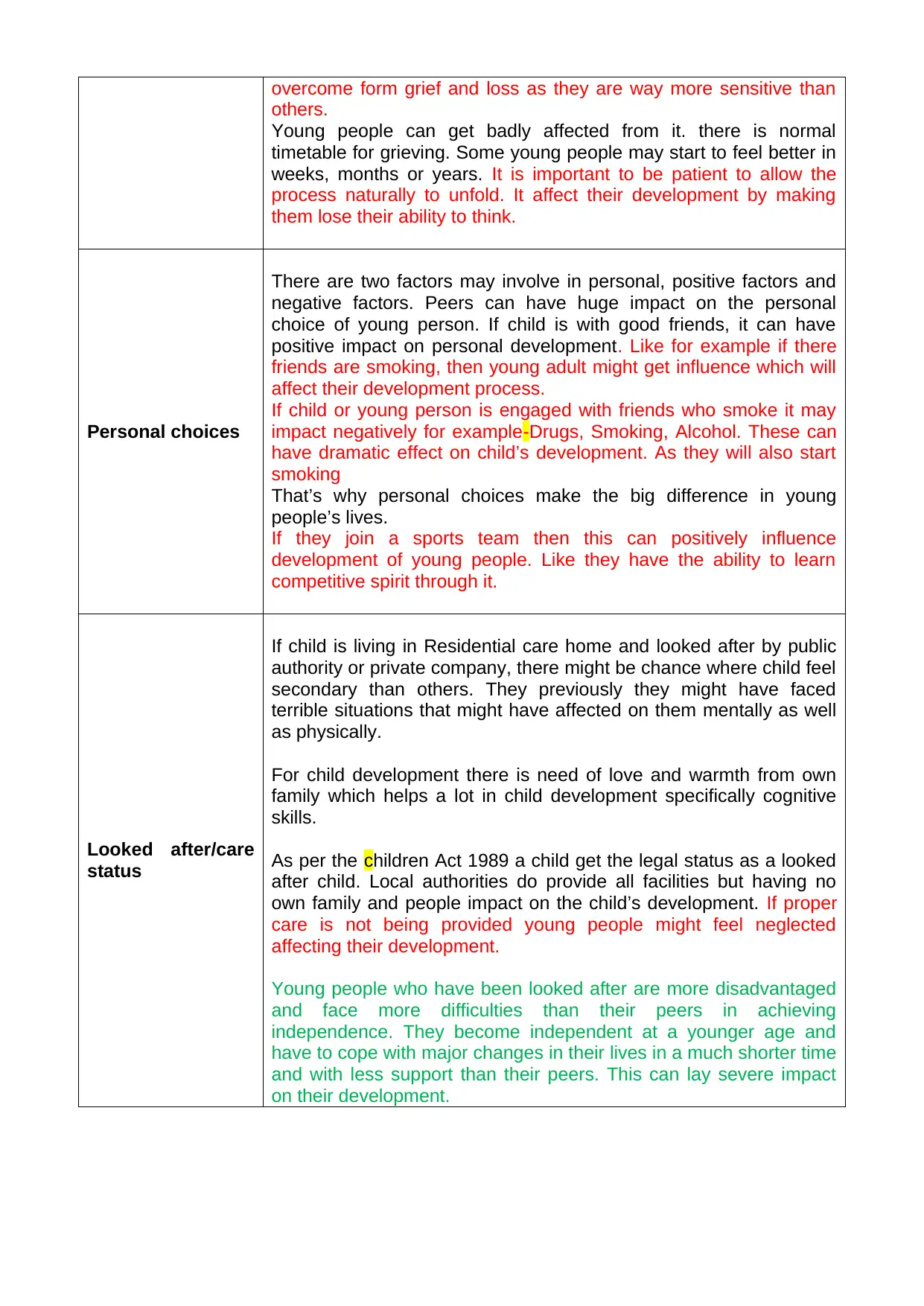
overcome form grief and loss as they are way more sensitive than
others.
Young people can get badly affected from it. there is normal
timetable for grieving. Some young people may start to feel better in
weeks, months or years. It is important to be patient to allow the
process naturally to unfold. It affect their development by making
them lose their ability to think.
Personal choices
There are two factors may involve in personal, positive factors and
negative factors. Peers can have huge impact on the personal
choice of young person. If child is with good friends, it can have
positive impact on personal development. Like for example if there
friends are smoking, then young adult might get influence which will
affect their development process.
If child or young person is engaged with friends who smoke it may
impact negatively for example-Drugs, Smoking, Alcohol. These can
have dramatic effect on child’s development. As they will also start
smoking
That’s why personal choices make the big difference in young
people’s lives.
If they join a sports team then this can positively influence
development of young people. Like they have the ability to learn
competitive spirit through it.
Looked after/care
status
If child is living in Residential care home and looked after by public
authority or private company, there might be chance where child feel
secondary than others. They previously they might have faced
terrible situations that might have affected on them mentally as well
as physically.
For child development there is need of love and warmth from own
family which helps a lot in child development specifically cognitive
skills.
As per the children Act 1989 a child get the legal status as a looked
after child. Local authorities do provide all facilities but having no
own family and people impact on the child’s development. If proper
care is not being provided young people might feel neglected
affecting their development.
Young people who have been looked after are more disadvantaged
and face more difficulties than their peers in achieving
independence. They become independent at a younger age and
have to cope with major changes in their lives in a much shorter time
and with less support than their peers. This can lay severe impact
on their development.
others.
Young people can get badly affected from it. there is normal
timetable for grieving. Some young people may start to feel better in
weeks, months or years. It is important to be patient to allow the
process naturally to unfold. It affect their development by making
them lose their ability to think.
Personal choices
There are two factors may involve in personal, positive factors and
negative factors. Peers can have huge impact on the personal
choice of young person. If child is with good friends, it can have
positive impact on personal development. Like for example if there
friends are smoking, then young adult might get influence which will
affect their development process.
If child or young person is engaged with friends who smoke it may
impact negatively for example-Drugs, Smoking, Alcohol. These can
have dramatic effect on child’s development. As they will also start
smoking
That’s why personal choices make the big difference in young
people’s lives.
If they join a sports team then this can positively influence
development of young people. Like they have the ability to learn
competitive spirit through it.
Looked after/care
status
If child is living in Residential care home and looked after by public
authority or private company, there might be chance where child feel
secondary than others. They previously they might have faced
terrible situations that might have affected on them mentally as well
as physically.
For child development there is need of love and warmth from own
family which helps a lot in child development specifically cognitive
skills.
As per the children Act 1989 a child get the legal status as a looked
after child. Local authorities do provide all facilities but having no
own family and people impact on the child’s development. If proper
care is not being provided young people might feel neglected
affecting their development.
Young people who have been looked after are more disadvantaged
and face more difficulties than their peers in achieving
independence. They become independent at a younger age and
have to cope with major changes in their lives in a much shorter time
and with less support than their peers. This can lay severe impact
on their development.
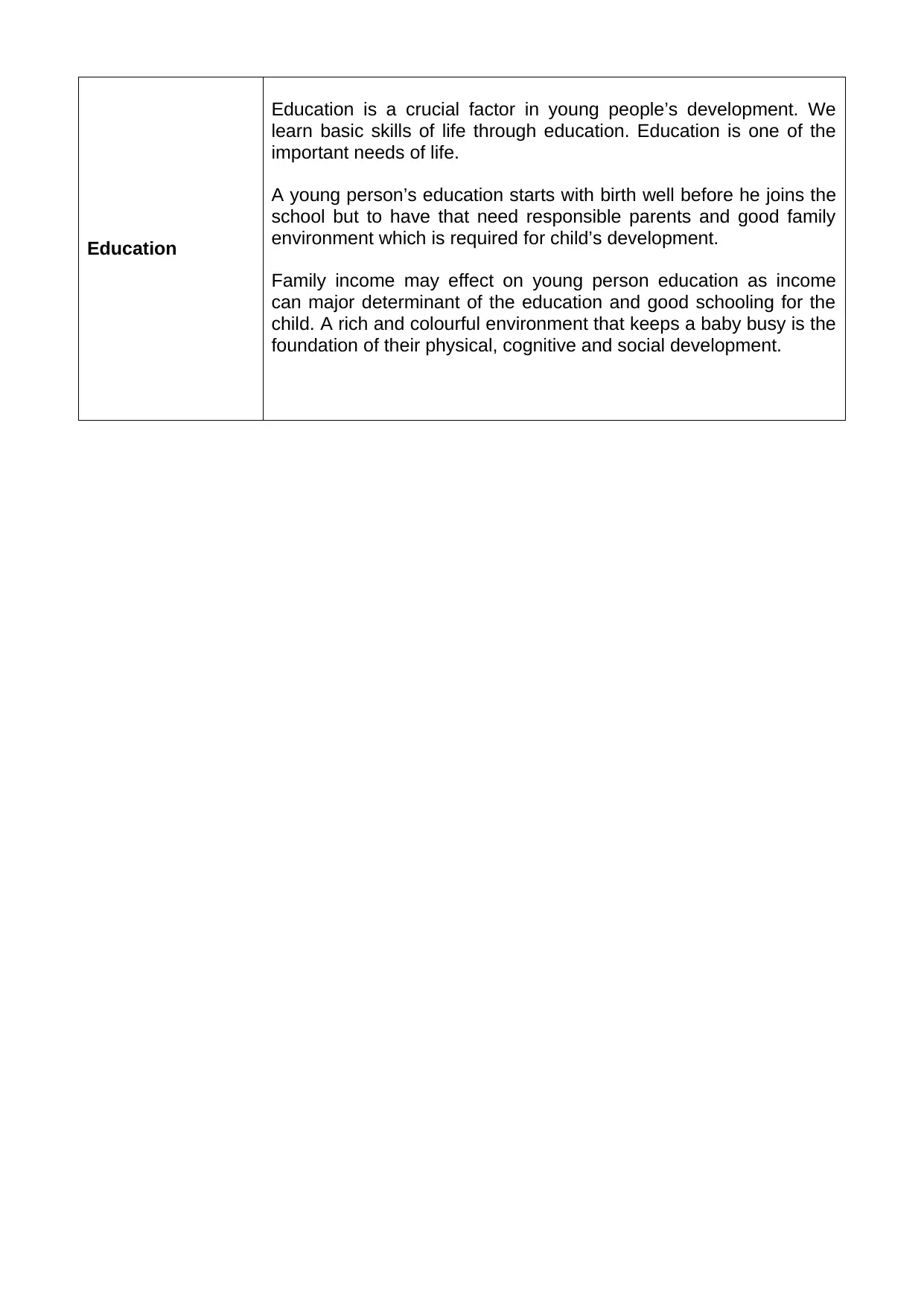
Education
Education is a crucial factor in young people’s development. We
learn basic skills of life through education. Education is one of the
important needs of life.
A young person’s education starts with birth well before he joins the
school but to have that need responsible parents and good family
environment which is required for child’s development.
Family income may effect on young person education as income
can major determinant of the education and good schooling for the
child. A rich and colourful environment that keeps a baby busy is the
foundation of their physical, cognitive and social development.
Education is a crucial factor in young people’s development. We
learn basic skills of life through education. Education is one of the
important needs of life.
A young person’s education starts with birth well before he joins the
school but to have that need responsible parents and good family
environment which is required for child’s development.
Family income may effect on young person education as income
can major determinant of the education and good schooling for the
child. A rich and colourful environment that keeps a baby busy is the
foundation of their physical, cognitive and social development.
⊘ This is a preview!⊘
Do you want full access?
Subscribe today to unlock all pages.

Trusted by 1+ million students worldwide
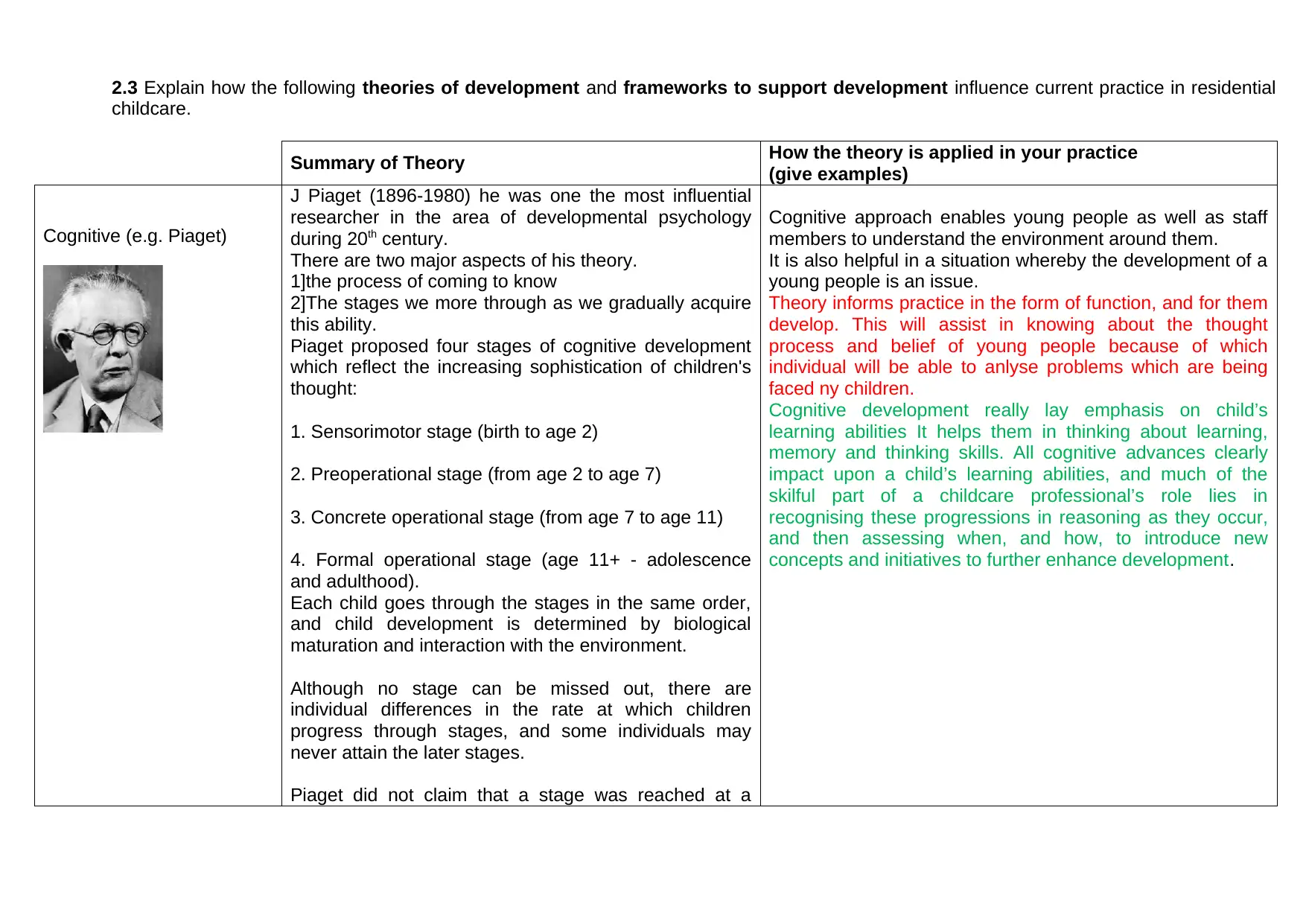
2.3 Explain how the following theories of development and frameworks to support development influence current practice in residential
childcare.
Summary of Theory How the theory is applied in your practice
(give examples)
Cognitive (e.g. Piaget)
J Piaget (1896-1980) he was one the most influential
researcher in the area of developmental psychology
during 20th century.
There are two major aspects of his theory.
1]the process of coming to know
2]The stages we more through as we gradually acquire
this ability.
Piaget proposed four stages of cognitive development
which reflect the increasing sophistication of children's
thought:
1. Sensorimotor stage (birth to age 2)
2. Preoperational stage (from age 2 to age 7)
3. Concrete operational stage (from age 7 to age 11)
4. Formal operational stage (age 11+ - adolescence
and adulthood).
Each child goes through the stages in the same order,
and child development is determined by biological
maturation and interaction with the environment.
Although no stage can be missed out, there are
individual differences in the rate at which children
progress through stages, and some individuals may
never attain the later stages.
Piaget did not claim that a stage was reached at a
Cognitive approach enables young people as well as staff
members to understand the environment around them.
It is also helpful in a situation whereby the development of a
young people is an issue.
Theory informs practice in the form of function, and for them
develop. This will assist in knowing about the thought
process and belief of young people because of which
individual will be able to anlyse problems which are being
faced ny children.
Cognitive development really lay emphasis on child’s
learning abilities It helps them in thinking about learning,
memory and thinking skills. All cognitive advances clearly
impact upon a child’s learning abilities, and much of the
skilful part of a childcare professional’s role lies in
recognising these progressions in reasoning as they occur,
and then assessing when, and how, to introduce new
concepts and initiatives to further enhance development.
childcare.
Summary of Theory How the theory is applied in your practice
(give examples)
Cognitive (e.g. Piaget)
J Piaget (1896-1980) he was one the most influential
researcher in the area of developmental psychology
during 20th century.
There are two major aspects of his theory.
1]the process of coming to know
2]The stages we more through as we gradually acquire
this ability.
Piaget proposed four stages of cognitive development
which reflect the increasing sophistication of children's
thought:
1. Sensorimotor stage (birth to age 2)
2. Preoperational stage (from age 2 to age 7)
3. Concrete operational stage (from age 7 to age 11)
4. Formal operational stage (age 11+ - adolescence
and adulthood).
Each child goes through the stages in the same order,
and child development is determined by biological
maturation and interaction with the environment.
Although no stage can be missed out, there are
individual differences in the rate at which children
progress through stages, and some individuals may
never attain the later stages.
Piaget did not claim that a stage was reached at a
Cognitive approach enables young people as well as staff
members to understand the environment around them.
It is also helpful in a situation whereby the development of a
young people is an issue.
Theory informs practice in the form of function, and for them
develop. This will assist in knowing about the thought
process and belief of young people because of which
individual will be able to anlyse problems which are being
faced ny children.
Cognitive development really lay emphasis on child’s
learning abilities It helps them in thinking about learning,
memory and thinking skills. All cognitive advances clearly
impact upon a child’s learning abilities, and much of the
skilful part of a childcare professional’s role lies in
recognising these progressions in reasoning as they occur,
and then assessing when, and how, to introduce new
concepts and initiatives to further enhance development.
Paraphrase This Document
Need a fresh take? Get an instant paraphrase of this document with our AI Paraphraser
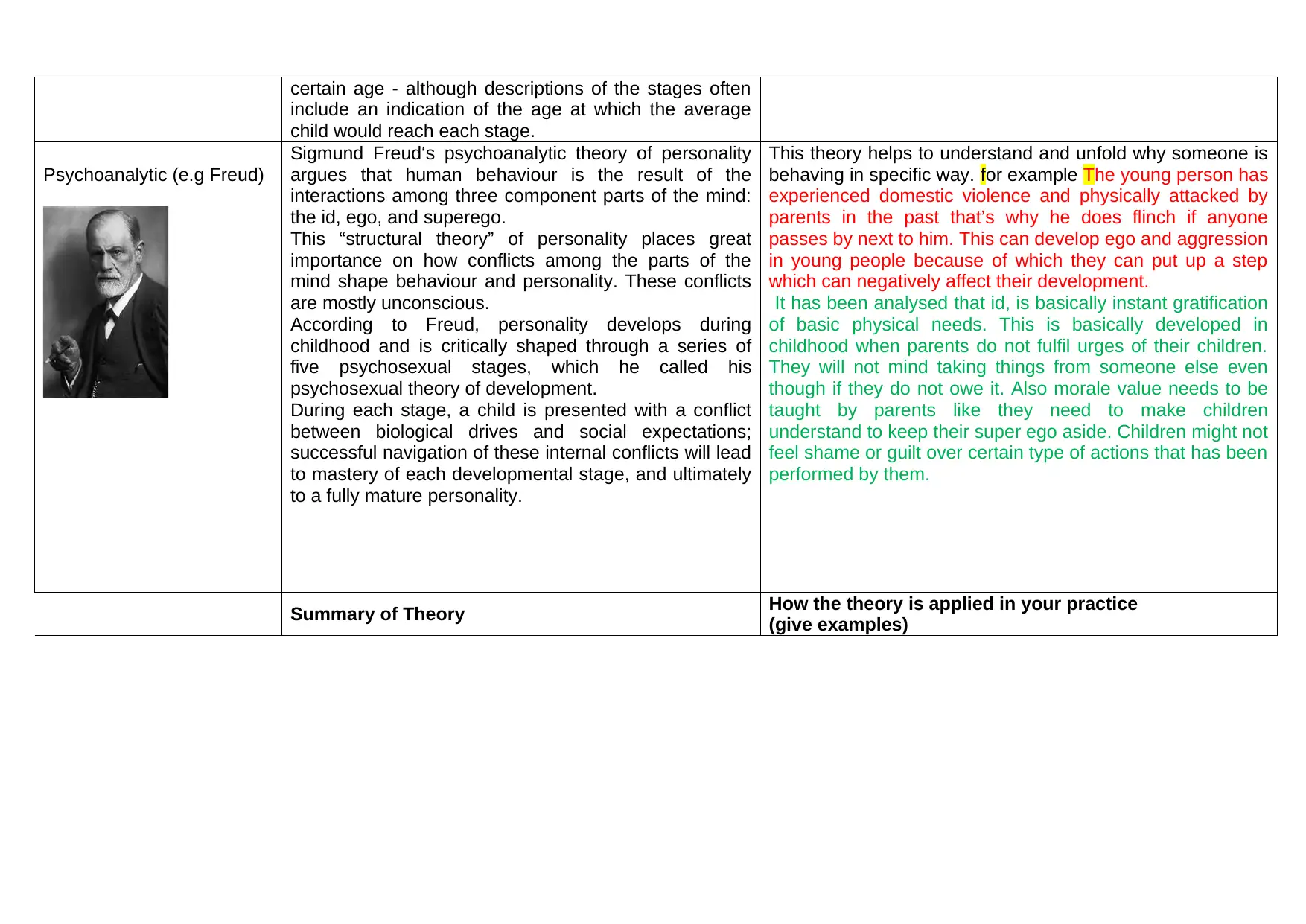
certain age - although descriptions of the stages often
include an indication of the age at which the average
child would reach each stage.
Psychoanalytic (e.g Freud)
Sigmund Freud‘s psychoanalytic theory of personality
argues that human behaviour is the result of the
interactions among three component parts of the mind:
the id, ego, and superego.
This “structural theory” of personality places great
importance on how conflicts among the parts of the
mind shape behaviour and personality. These conflicts
are mostly unconscious.
According to Freud, personality develops during
childhood and is critically shaped through a series of
five psychosexual stages, which he called his
psychosexual theory of development.
During each stage, a child is presented with a conflict
between biological drives and social expectations;
successful navigation of these internal conflicts will lead
to mastery of each developmental stage, and ultimately
to a fully mature personality.
This theory helps to understand and unfold why someone is
behaving in specific way. for example The young person has
experienced domestic violence and physically attacked by
parents in the past that’s why he does flinch if anyone
passes by next to him. This can develop ego and aggression
in young people because of which they can put up a step
which can negatively affect their development.
It has been analysed that id, is basically instant gratification
of basic physical needs. This is basically developed in
childhood when parents do not fulfil urges of their children.
They will not mind taking things from someone else even
though if they do not owe it. Also morale value needs to be
taught by parents like they need to make children
understand to keep their super ego aside. Children might not
feel shame or guilt over certain type of actions that has been
performed by them.
Summary of Theory How the theory is applied in your practice
(give examples)
include an indication of the age at which the average
child would reach each stage.
Psychoanalytic (e.g Freud)
Sigmund Freud‘s psychoanalytic theory of personality
argues that human behaviour is the result of the
interactions among three component parts of the mind:
the id, ego, and superego.
This “structural theory” of personality places great
importance on how conflicts among the parts of the
mind shape behaviour and personality. These conflicts
are mostly unconscious.
According to Freud, personality develops during
childhood and is critically shaped through a series of
five psychosexual stages, which he called his
psychosexual theory of development.
During each stage, a child is presented with a conflict
between biological drives and social expectations;
successful navigation of these internal conflicts will lead
to mastery of each developmental stage, and ultimately
to a fully mature personality.
This theory helps to understand and unfold why someone is
behaving in specific way. for example The young person has
experienced domestic violence and physically attacked by
parents in the past that’s why he does flinch if anyone
passes by next to him. This can develop ego and aggression
in young people because of which they can put up a step
which can negatively affect their development.
It has been analysed that id, is basically instant gratification
of basic physical needs. This is basically developed in
childhood when parents do not fulfil urges of their children.
They will not mind taking things from someone else even
though if they do not owe it. Also morale value needs to be
taught by parents like they need to make children
understand to keep their super ego aside. Children might not
feel shame or guilt over certain type of actions that has been
performed by them.
Summary of Theory How the theory is applied in your practice
(give examples)
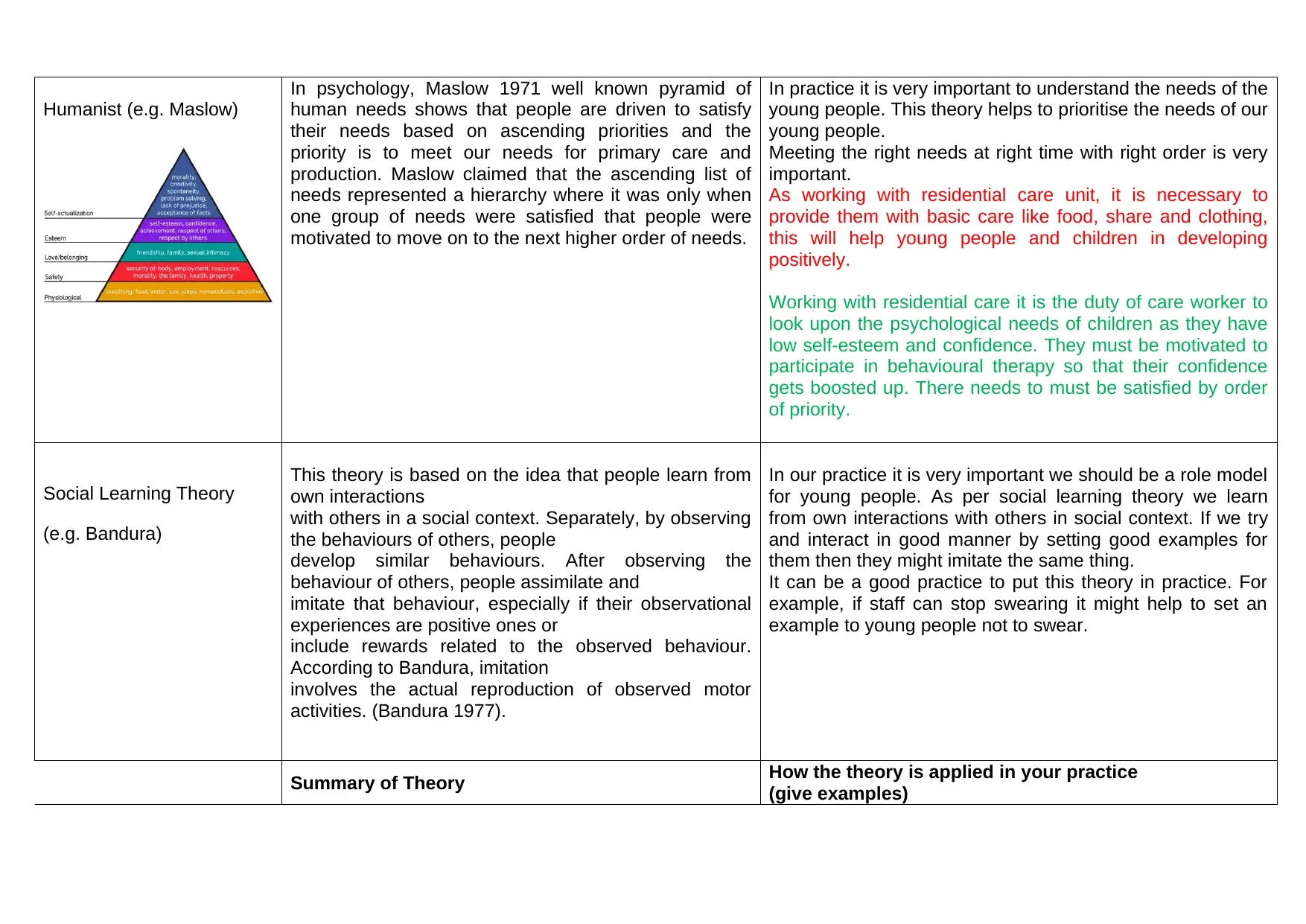
Humanist (e.g. Maslow)
In psychology, Maslow 1971 well known pyramid of
human needs shows that people are driven to satisfy
their needs based on ascending priorities and the
priority is to meet our needs for primary care and
production. Maslow claimed that the ascending list of
needs represented a hierarchy where it was only when
one group of needs were satisfied that people were
motivated to move on to the next higher order of needs.
In practice it is very important to understand the needs of the
young people. This theory helps to prioritise the needs of our
young people.
Meeting the right needs at right time with right order is very
important.
As working with residential care unit, it is necessary to
provide them with basic care like food, share and clothing,
this will help young people and children in developing
positively.
Working with residential care it is the duty of care worker to
look upon the psychological needs of children as they have
low self-esteem and confidence. They must be motivated to
participate in behavioural therapy so that their confidence
gets boosted up. There needs to must be satisfied by order
of priority.
Social Learning Theory
(e.g. Bandura)
This theory is based on the idea that people learn from
own interactions
with others in a social context. Separately, by observing
the behaviours of others, people
develop similar behaviours. After observing the
behaviour of others, people assimilate and
imitate that behaviour, especially if their observational
experiences are positive ones or
include rewards related to the observed behaviour.
According to Bandura, imitation
involves the actual reproduction of observed motor
activities. (Bandura 1977).
In our practice it is very important we should be a role model
for young people. As per social learning theory we learn
from own interactions with others in social context. If we try
and interact in good manner by setting good examples for
them then they might imitate the same thing.
It can be a good practice to put this theory in practice. For
example, if staff can stop swearing it might help to set an
example to young people not to swear.
Summary of Theory How the theory is applied in your practice
(give examples)
In psychology, Maslow 1971 well known pyramid of
human needs shows that people are driven to satisfy
their needs based on ascending priorities and the
priority is to meet our needs for primary care and
production. Maslow claimed that the ascending list of
needs represented a hierarchy where it was only when
one group of needs were satisfied that people were
motivated to move on to the next higher order of needs.
In practice it is very important to understand the needs of the
young people. This theory helps to prioritise the needs of our
young people.
Meeting the right needs at right time with right order is very
important.
As working with residential care unit, it is necessary to
provide them with basic care like food, share and clothing,
this will help young people and children in developing
positively.
Working with residential care it is the duty of care worker to
look upon the psychological needs of children as they have
low self-esteem and confidence. They must be motivated to
participate in behavioural therapy so that their confidence
gets boosted up. There needs to must be satisfied by order
of priority.
Social Learning Theory
(e.g. Bandura)
This theory is based on the idea that people learn from
own interactions
with others in a social context. Separately, by observing
the behaviours of others, people
develop similar behaviours. After observing the
behaviour of others, people assimilate and
imitate that behaviour, especially if their observational
experiences are positive ones or
include rewards related to the observed behaviour.
According to Bandura, imitation
involves the actual reproduction of observed motor
activities. (Bandura 1977).
In our practice it is very important we should be a role model
for young people. As per social learning theory we learn
from own interactions with others in social context. If we try
and interact in good manner by setting good examples for
them then they might imitate the same thing.
It can be a good practice to put this theory in practice. For
example, if staff can stop swearing it might help to set an
example to young people not to swear.
Summary of Theory How the theory is applied in your practice
(give examples)
⊘ This is a preview!⊘
Do you want full access?
Subscribe today to unlock all pages.

Trusted by 1+ million students worldwide
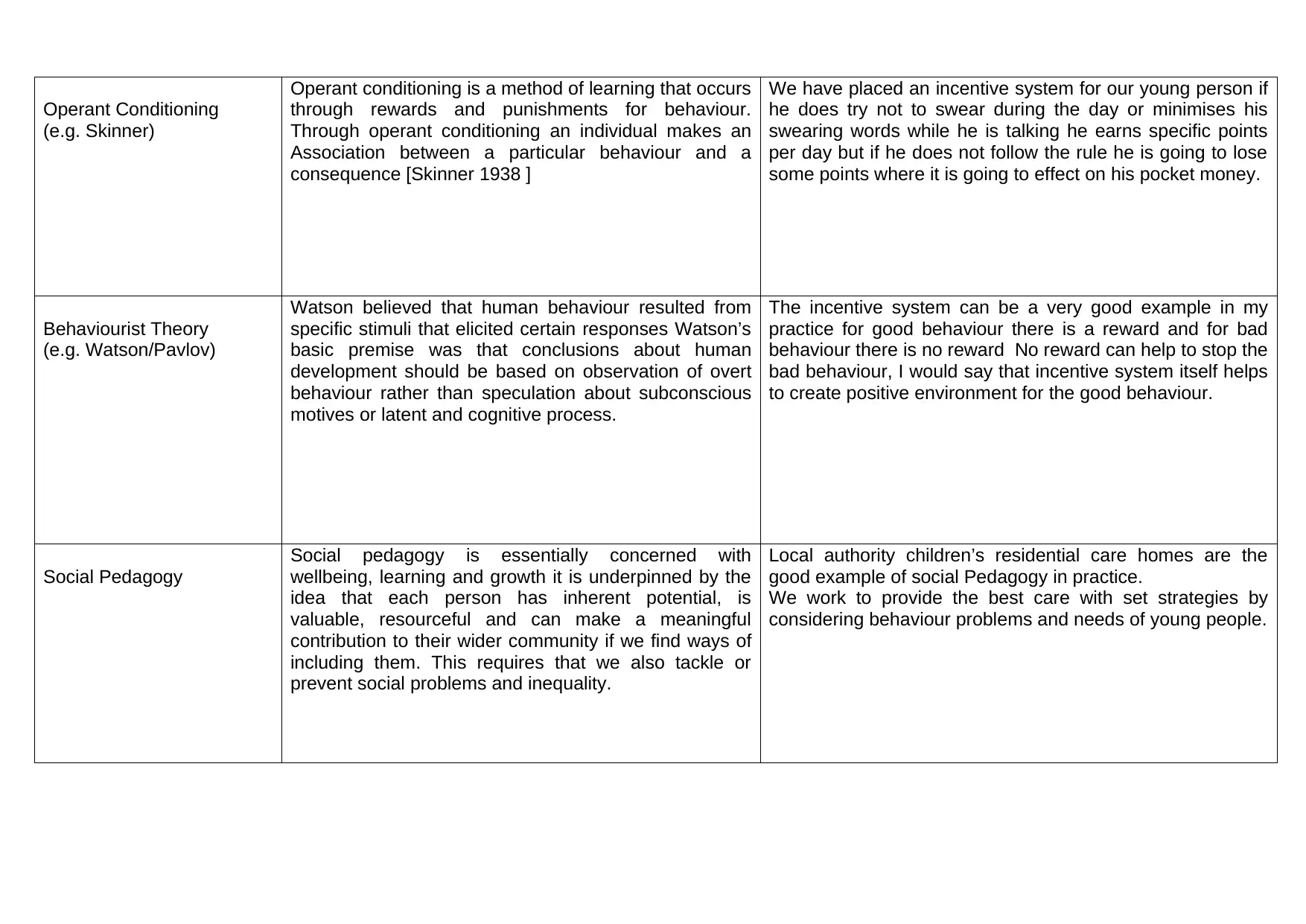
Operant Conditioning
(e.g. Skinner)
Operant conditioning is a method of learning that occurs
through rewards and punishments for behaviour.
Through operant conditioning an individual makes an
Association between a particular behaviour and a
consequence [Skinner 1938 ]
We have placed an incentive system for our young person if
he does try not to swear during the day or minimises his
swearing words while he is talking he earns specific points
per day but if he does not follow the rule he is going to lose
some points where it is going to effect on his pocket money.
Behaviourist Theory
(e.g. Watson/Pavlov)
Watson believed that human behaviour resulted from
specific stimuli that elicited certain responses Watson’s
basic premise was that conclusions about human
development should be based on observation of overt
behaviour rather than speculation about subconscious
motives or latent and cognitive process.
The incentive system can be a very good example in my
practice for good behaviour there is a reward and for bad
behaviour there is no reward No reward can help to stop the
bad behaviour, I would say that incentive system itself helps
to create positive environment for the good behaviour.
Social Pedagogy
Social pedagogy is essentially concerned with
wellbeing, learning and growth it is underpinned by the
idea that each person has inherent potential, is
valuable, resourceful and can make a meaningful
contribution to their wider community if we find ways of
including them. This requires that we also tackle or
prevent social problems and inequality.
Local authority children’s residential care homes are the
good example of social Pedagogy in practice.
We work to provide the best care with set strategies by
considering behaviour problems and needs of young people.
(e.g. Skinner)
Operant conditioning is a method of learning that occurs
through rewards and punishments for behaviour.
Through operant conditioning an individual makes an
Association between a particular behaviour and a
consequence [Skinner 1938 ]
We have placed an incentive system for our young person if
he does try not to swear during the day or minimises his
swearing words while he is talking he earns specific points
per day but if he does not follow the rule he is going to lose
some points where it is going to effect on his pocket money.
Behaviourist Theory
(e.g. Watson/Pavlov)
Watson believed that human behaviour resulted from
specific stimuli that elicited certain responses Watson’s
basic premise was that conclusions about human
development should be based on observation of overt
behaviour rather than speculation about subconscious
motives or latent and cognitive process.
The incentive system can be a very good example in my
practice for good behaviour there is a reward and for bad
behaviour there is no reward No reward can help to stop the
bad behaviour, I would say that incentive system itself helps
to create positive environment for the good behaviour.
Social Pedagogy
Social pedagogy is essentially concerned with
wellbeing, learning and growth it is underpinned by the
idea that each person has inherent potential, is
valuable, resourceful and can make a meaningful
contribution to their wider community if we find ways of
including them. This requires that we also tackle or
prevent social problems and inequality.
Local authority children’s residential care homes are the
good example of social Pedagogy in practice.
We work to provide the best care with set strategies by
considering behaviour problems and needs of young people.
Paraphrase This Document
Need a fresh take? Get an instant paraphrase of this document with our AI Paraphraser
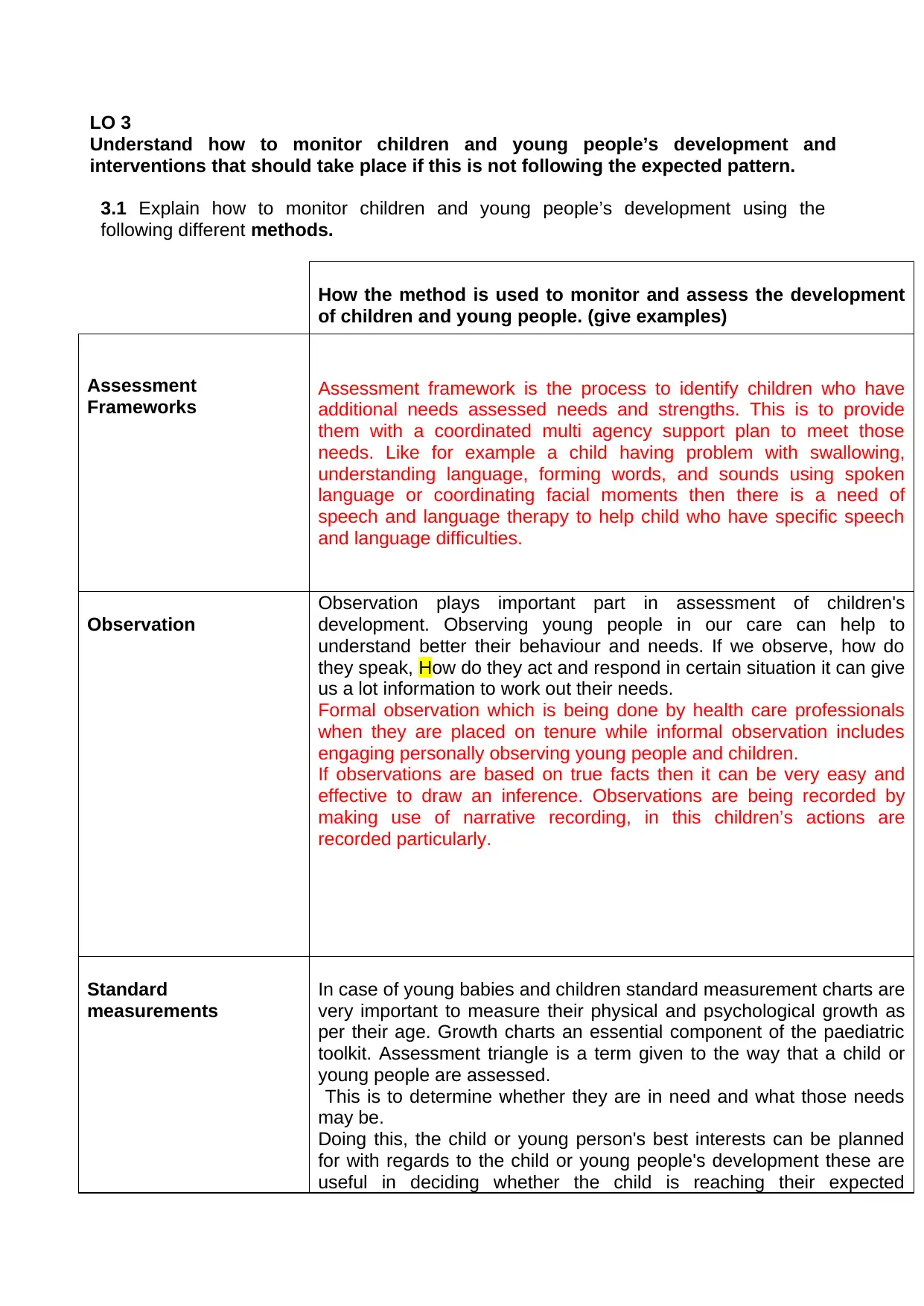
LO 3
Understand how to monitor children and young people’s development and
interventions that should take place if this is not following the expected pattern.
3.1 Explain how to monitor children and young people’s development using the
following different methods.
How the method is used to monitor and assess the development
of children and young people. (give examples)
Assessment
Frameworks Assessment framework is the process to identify children who have
additional needs assessed needs and strengths. This is to provide
them with a coordinated multi agency support plan to meet those
needs. Like for example a child having problem with swallowing,
understanding language, forming words, and sounds using spoken
language or coordinating facial moments then there is a need of
speech and language therapy to help child who have specific speech
and language difficulties.
Observation
Observation plays important part in assessment of children's
development. Observing young people in our care can help to
understand better their behaviour and needs. If we observe, how do
they speak, How do they act and respond in certain situation it can give
us a lot information to work out their needs.
Formal observation which is being done by health care professionals
when they are placed on tenure while informal observation includes
engaging personally observing young people and children.
If observations are based on true facts then it can be very easy and
effective to draw an inference. Observations are being recorded by
making use of narrative recording, in this children’s actions are
recorded particularly.
Standard
measurements
In case of young babies and children standard measurement charts are
very important to measure their physical and psychological growth as
per their age. Growth charts an essential component of the paediatric
toolkit. Assessment triangle is a term given to the way that a child or
young people are assessed.
This is to determine whether they are in need and what those needs
may be.
Doing this, the child or young person's best interests can be planned
for with regards to the child or young people's development these are
useful in deciding whether the child is reaching their expected
Understand how to monitor children and young people’s development and
interventions that should take place if this is not following the expected pattern.
3.1 Explain how to monitor children and young people’s development using the
following different methods.
How the method is used to monitor and assess the development
of children and young people. (give examples)
Assessment
Frameworks Assessment framework is the process to identify children who have
additional needs assessed needs and strengths. This is to provide
them with a coordinated multi agency support plan to meet those
needs. Like for example a child having problem with swallowing,
understanding language, forming words, and sounds using spoken
language or coordinating facial moments then there is a need of
speech and language therapy to help child who have specific speech
and language difficulties.
Observation
Observation plays important part in assessment of children's
development. Observing young people in our care can help to
understand better their behaviour and needs. If we observe, how do
they speak, How do they act and respond in certain situation it can give
us a lot information to work out their needs.
Formal observation which is being done by health care professionals
when they are placed on tenure while informal observation includes
engaging personally observing young people and children.
If observations are based on true facts then it can be very easy and
effective to draw an inference. Observations are being recorded by
making use of narrative recording, in this children’s actions are
recorded particularly.
Standard
measurements
In case of young babies and children standard measurement charts are
very important to measure their physical and psychological growth as
per their age. Growth charts an essential component of the paediatric
toolkit. Assessment triangle is a term given to the way that a child or
young people are assessed.
This is to determine whether they are in need and what those needs
may be.
Doing this, the child or young person's best interests can be planned
for with regards to the child or young people's development these are
useful in deciding whether the child is reaching their expected
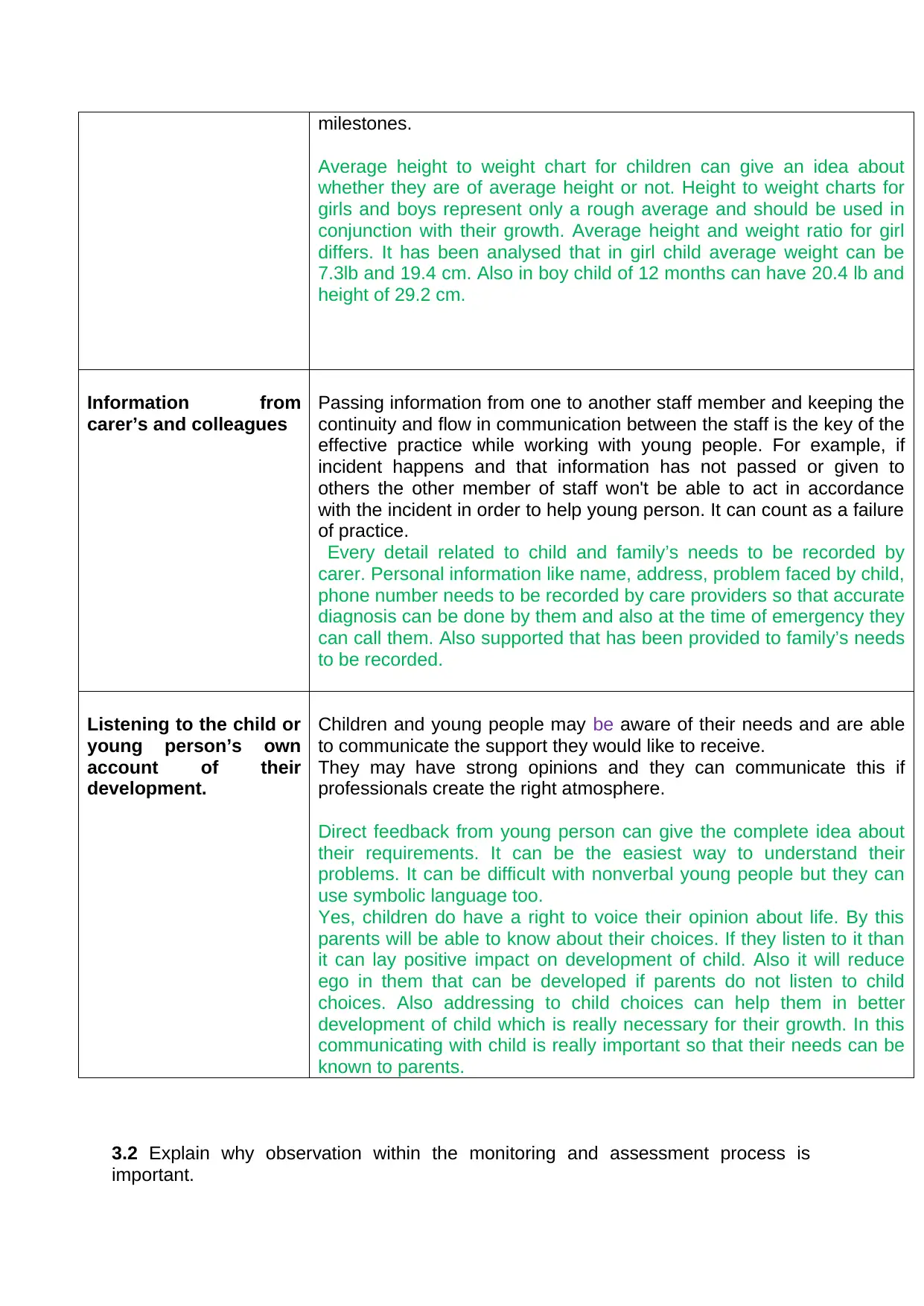
milestones.
Average height to weight chart for children can give an idea about
whether they are of average height or not. Height to weight charts for
girls and boys represent only a rough average and should be used in
conjunction with their growth. Average height and weight ratio for girl
differs. It has been analysed that in girl child average weight can be
7.3lb and 19.4 cm. Also in boy child of 12 months can have 20.4 lb and
height of 29.2 cm.
Information from
carer’s and colleagues
Passing information from one to another staff member and keeping the
continuity and flow in communication between the staff is the key of the
effective practice while working with young people. For example, if
incident happens and that information has not passed or given to
others the other member of staff won't be able to act in accordance
with the incident in order to help young person. It can count as a failure
of practice.
Every detail related to child and family’s needs to be recorded by
carer. Personal information like name, address, problem faced by child,
phone number needs to be recorded by care providers so that accurate
diagnosis can be done by them and also at the time of emergency they
can call them. Also supported that has been provided to family’s needs
to be recorded.
Listening to the child or
young person’s own
account of their
development.
Children and young people may be aware of their needs and are able
to communicate the support they would like to receive.
They may have strong opinions and they can communicate this if
professionals create the right atmosphere.
Direct feedback from young person can give the complete idea about
their requirements. It can be the easiest way to understand their
problems. It can be difficult with nonverbal young people but they can
use symbolic language too.
Yes, children do have a right to voice their opinion about life. By this
parents will be able to know about their choices. If they listen to it than
it can lay positive impact on development of child. Also it will reduce
ego in them that can be developed if parents do not listen to child
choices. Also addressing to child choices can help them in better
development of child which is really necessary for their growth. In this
communicating with child is really important so that their needs can be
known to parents.
3.2 Explain why observation within the monitoring and assessment process is
important.
Average height to weight chart for children can give an idea about
whether they are of average height or not. Height to weight charts for
girls and boys represent only a rough average and should be used in
conjunction with their growth. Average height and weight ratio for girl
differs. It has been analysed that in girl child average weight can be
7.3lb and 19.4 cm. Also in boy child of 12 months can have 20.4 lb and
height of 29.2 cm.
Information from
carer’s and colleagues
Passing information from one to another staff member and keeping the
continuity and flow in communication between the staff is the key of the
effective practice while working with young people. For example, if
incident happens and that information has not passed or given to
others the other member of staff won't be able to act in accordance
with the incident in order to help young person. It can count as a failure
of practice.
Every detail related to child and family’s needs to be recorded by
carer. Personal information like name, address, problem faced by child,
phone number needs to be recorded by care providers so that accurate
diagnosis can be done by them and also at the time of emergency they
can call them. Also supported that has been provided to family’s needs
to be recorded.
Listening to the child or
young person’s own
account of their
development.
Children and young people may be aware of their needs and are able
to communicate the support they would like to receive.
They may have strong opinions and they can communicate this if
professionals create the right atmosphere.
Direct feedback from young person can give the complete idea about
their requirements. It can be the easiest way to understand their
problems. It can be difficult with nonverbal young people but they can
use symbolic language too.
Yes, children do have a right to voice their opinion about life. By this
parents will be able to know about their choices. If they listen to it than
it can lay positive impact on development of child. Also it will reduce
ego in them that can be developed if parents do not listen to child
choices. Also addressing to child choices can help them in better
development of child which is really necessary for their growth. In this
communicating with child is really important so that their needs can be
known to parents.
3.2 Explain why observation within the monitoring and assessment process is
important.
⊘ This is a preview!⊘
Do you want full access?
Subscribe today to unlock all pages.

Trusted by 1+ million students worldwide
1 out of 23
Related Documents
Your All-in-One AI-Powered Toolkit for Academic Success.
+13062052269
info@desklib.com
Available 24*7 on WhatsApp / Email
![[object Object]](/_next/static/media/star-bottom.7253800d.svg)
Unlock your academic potential
Copyright © 2020–2025 A2Z Services. All Rights Reserved. Developed and managed by ZUCOL.





